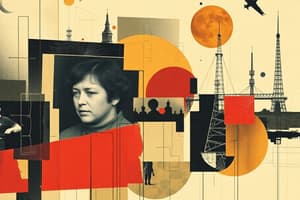Podcast
Questions and Answers
芸術の定義として、最も適切なものはどれですか?
芸術の定義として、最も適切なものはどれですか?
- 人間の活動や創造物であり、アイデア、感情、または美学の表現や伝達を含むもの (correct)
- 特定の個人や団体によって認められた作品
- 歴史的に価値のある、博物館に展示されている作品
- 特定の技法を用いて作られた美しい装飾品
芸術の歴史的機能として適切でないものはどれですか?
芸術の歴史的機能として適切でないものはどれですか?
- 政治的な解説
- 物語の伝達
- 美的楽しさ
- 科学的な研究の発表 (correct)
芸術の要素に含まれないものはどれですか?
芸術の要素に含まれないものはどれですか?
- 色彩(Color)
- 線(Line)
- 時間(Time) (correct)
- 形(Shape)
芸術の原則における「バランス」とは、何を意味しますか?
芸術の原則における「バランス」とは、何を意味しますか?
芸術における「コントラスト」の主な目的は何ですか?
芸術における「コントラスト」の主な目的は何ですか?
芸術における「強調」とは、何を指しますか?
芸術における「強調」とは、何を指しますか?
芸術における「動き (Movement)」を表現するために用いられる要素として、最も適切なものはどれですか?
芸術における「動き (Movement)」を表現するために用いられる要素として、最も適切なものはどれですか?
芸術における「統一性」を実現するために重要な要素は何ですか?
芸術における「統一性」を実現するために重要な要素は何ですか?
次のうち、芸術のスタイルやトレンドに関する記述として正しくないものはどれですか?
次のうち、芸術のスタイルやトレンドに関する記述として正しくないものはどれですか?
美術が社会において果たす役割として、適切でないものは次のうちどれですか?
美術が社会において果たす役割として、適切でないものは次のうちどれですか?
美術作品が持つ機能として、歴史的出来事や人物を表現することの他に、含まれないものはどれですか?
美術作品が持つ機能として、歴史的出来事や人物を表現することの他に、含まれないものはどれですか?
美術が社会に与える影響について、最も適切な説明はどれですか?
美術が社会に与える影響について、最も適切な説明はどれですか?
社会における美術の役割として、誤っているものはどれですか?
社会における美術の役割として、誤っているものはどれですか?
美術作品が社会に対して行う機能で、適切でないものは次のうちどれですか?
美術作品が社会に対して行う機能で、適切でないものは次のうちどれですか?
美術が文化の保存にどのように貢献するかを説明した文として、最も適切なものはどれですか?
美術が文化の保存にどのように貢献するかを説明した文として、最も適切なものはどれですか?
美術が持つ可能性として、社会の信念、価値観、理想に影響を与えることの他に、最も関係の薄いものはどれですか?
美術が持つ可能性として、社会の信念、価値観、理想に影響を与えることの他に、最も関係の薄いものはどれですか?
社会における美術の役割として適切でないものはどれですか?
社会における美術の役割として適切でないものはどれですか?
美術が政治的影響力を持つ例として、最も適切なものはどれですか?
美術が政治的影響力を持つ例として、最も適切なものはどれですか?
Flashcards
美的楽しみ
美的楽しみ
視覚的な喜びを生み出すこと。
感情表現
感情表現
感情や経験を伝えること。
社会批評
社会批評
社会問題を批判したり、反映したりすること。
文化保存
文化保存
Signup and view all the flashcards
歴史的記録
歴史的記録
Signup and view all the flashcards
政治的影響
政治的影響
Signup and view all the flashcards
アートと社会
アートと社会
Signup and view all the flashcards
社会批評としてのアート
社会批評としてのアート
Signup and view all the flashcards
文化的アイデンティティにおけるアート
文化的アイデンティティにおけるアート
Signup and view all the flashcards
芸術とは?
芸術とは?
Signup and view all the flashcards
芸術の象徴性
芸術の象徴性
Signup and view all the flashcards
芸術の機能
芸術の機能
Signup and view all the flashcards
芸術運動
芸術運動
Signup and view all the flashcards
芸術の要素
芸術の要素
Signup and view all the flashcards
線
線
Signup and view all the flashcards
形
形
Signup and view all the flashcards
形態
形態
Signup and view all the flashcards
空間
空間
Signup and view all the flashcards
Study Notes
Defining Art
- Art encompasses diverse human activities and creations, including painting, sculpture, music, literature, dance, and architecture.
- Art often expresses or communicates ideas, emotions, or aesthetic qualities.
- Art is a symbolic representation, reflecting cultural values and beliefs.
- The definition of art is subjective and constantly evolving, with varying interpretations across cultures and individuals.
Historical Perspectives on Art
- Throughout history, art served various purposes, including aesthetic appreciation, storytelling, religious practice, political commentary, and social critique.
- Specific historical periods fostered unique art styles and movements. Examples include the Renaissance, Baroque, Impressionism, and Surrealism.
- Art movements are often shaped by the social and cultural context of their time.
Elements of Art
- Art employs fundamental elements to create meaning and visual impact. These components include line, shape, form, space, color, texture, and value (light and dark).
- Line defines boundaries and suggests direction.
- Shape refers to two-dimensional areas.
- Form refers to three-dimensional shapes.
- Space encompasses the area surrounding and within an artwork.
- Color evokes emotions and influences perception.
- Texture refers to the surface quality or feel of an artwork.
- Value describes the range of light and dark in an artwork.
Principles of Art
- Artists utilize principles like balance, contrast, emphasis, movement, pattern, proportion, and unity to arrange art elements, creating diverse visual effects.
- Balance distributes visual weight, creating stability.
- Contrast highlights aspects through differences.
- Emphasis draws attention to specific areas or elements.
- Movement employs lines, shapes, and forms to suggest direction or action.
- Pattern involves repeating an element or motif.
- Proportion defines size relationships between elements.
- Unity creates a harmonious and cohesive effect.
Styles and Trends in Art
- Diverse art styles reflect varying cultural values, philosophical viewpoints, and artistic explorations.
- New styles emerge and existing ones gain or lose prominence over time.
- Styles can be categorized by characteristics, technical approaches, and the era in which they emerged.
Functions of Art
- Art serves multiple functions, including:
- Aesthetic enjoyment: creating visual pleasure.
- Emotional expression: conveying feelings and experiences.
- Social commentary: criticizing or reflecting on social issues.
- Cultural preservation: documenting and sharing cultural practices.
- Historical documentation: depicting historical events and figures.
- Political influence: promoting specific agendas or ideologies.
- Art can reflect or influence societal beliefs, values, and ideals.
Art and Society
- Art is inextricably linked to society and culture, mirroring societal values, beliefs, and experiences.
- Art serves as a tool for social criticism and political expression.
- Art plays a crucial role in shaping cultural identity and understanding for individuals and communities.
Studying That Suits You
Use AI to generate personalized quizzes and flashcards to suit your learning preferences.




